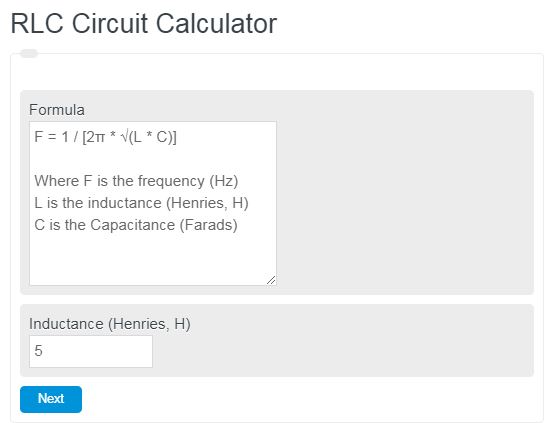Enter the total capacitance and total inductance of an RLC circuit to calculate the frequency of that circuit. An RLC circuit consists of 3 components, resistance, impedance, and capacitance.
- RC Circuit Calculator
- Capacitance Calculator
- Electric Field Calculator
- Capacitive Reactance Calculator
RLC Circuit Formula
The following equation can be used to calculate the frequency of an RLC circuit.
F = 1 / [2π * √(L * C)]
- Where F is the frequency (Hz)
- L is the inductance (Henries, H)
- C is the Capacitance (Farads)
What is an RLC Circuit?
An RLC circuit is an electrical circuit that consists of three main components: a resistor (R), an inductor (L), and a capacitor (C). These components are interconnected in a specific way to create a circuit that exhibits certain electrical properties.
RLC Circuit Uses
In this case, the equation can only be used when these three components are combined in a series. This would not apply if they were connected in some other way.
The three main uses for RLC Circuit are as follows:
- Filters
- Tuning Circuits
- Oscillators circuits.
Oscillator circuits are likely the most common. These can convert DC signal to AC signal.
How to calculate RLC circuit frequency?
How to calculate an RLC circuit frequency?
- First, determine the inductance.
Measure the inductance of the inductor.
- Next, measure the capacitance.
Measure the capacitance of the circuit.
- Finally, calculate the frequency.
Use the equation above to calculate the frequency.
FAQ
What is the significance of the resistor in an RLC circuit?
The resistor in an RLC circuit plays a crucial role by limiting the flow of electric current, thereby controlling the rate at which energy is dissipated as heat within the circuit. This helps in managing the energy transfer efficiently and ensures the circuit operates within safe parameters.
How does the inductor store energy in an RLC circuit?
In an RLC circuit, the inductor stores energy in the form of a magnetic field when electric current flows through it. This storage of energy is crucial for the circuit’s operation, especially in applications like filters and oscillators, where the energy can be released or absorbed by the circuit as needed.
Can RLC circuits operate with direct current (DC)?
While RLC circuits are primarily designed to operate with alternating current (AC) due to their reactive components, they can technically be connected to a DC source. However, their behavior and functionality will be significantly different from AC operation, as the reactive components (inductor and capacitor) do not behave the same way with a steady-state DC supply.
Why are RLC circuits used as filters?
RLC circuits are used as filters due to their ability to selectively allow signals of certain frequencies to pass while blocking others. This is achieved through the specific arrangement and values of the resistor, inductor, and capacitor, which determine the circuit’s resonant frequency. By tuning these components, RLC circuits can be used as low-pass, high-pass, band-pass, or band-stop filters, making them extremely versatile in signal processing applications.

